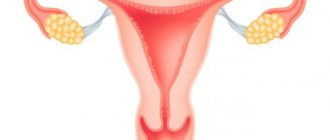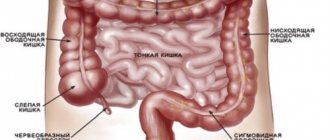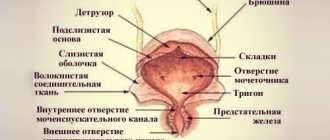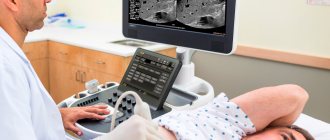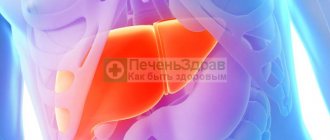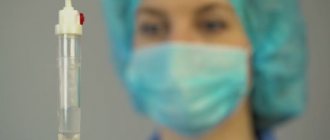- Location and functions of the liver
- Anatomical structure of the liver
- Liver diseases
- Treatment of diseases
- Prevention of liver diseases
The liver is a unique organ of the human body. This is primarily due to its versatility, because it is capable of performing about 500 different functions. The liver is the largest organ in the human digestive system. But the main feature is the ability to regenerate. This is one of the few organs that can regenerate on its own given favorable conditions. The liver is extremely important for the human body, but what main functions does it perform, what is its structure and where is it located in the human body?
Location and functions of the liver
The liver is an organ of the digestive system, which is located in the right hypochondrium under the diaphragm and in normal condition does not extend beyond the ribs. Only in childhood can it protrude a little, but this phenomenon is considered normal until the age of 7. Weight depends on the age of the person. So, in an adult it is 1500-1700 g. A change in the size or weight of an organ indicates the development of pathological processes in the body.
As already mentioned, the liver performs many functions, the main of which are:
- Detoxification. The liver is the main cleansing organ of the human body. All products of metabolism, decay, toxins, poisons and other substances from the gastrointestinal tract enter the liver, where the organ “neutralizes” them. After detoxification, the organ removes harmless waste products with blood or bile, from where they enter the intestines and are excreted along with feces.
- The production of good cholesterol, which takes part in the synthesis of bile, regulates hormonal levels and is involved in the formation of cell membranes.
- Accelerating the synthesis of proteins, which are extremely important for normal human life.
- Synthesis of bile, which takes part in the process of food digestion and fat metabolism.
- Normalization of carbohydrate metabolism in the body, increasing energy potential. First of all, the liver produces glycogen and glucose.
- Regulation of pigment metabolism - removal of bilirubin from the body along with bile.
- The breakdown of fats into ketone bodies and fatty acids.
The liver is capable of regeneration. An organ can recover completely, even if only 25% of it is preserved. Regeneration occurs through growth and faster cell division. Moreover, this process stops as soon as the organ reaches the desired size.
How to find out where a person's liver is located
The liver plays an important role in the body of all vertebrates, including humans.
This organ is a gland capable of neutralizing poisons and toxins ingested through food or other means.
The liver cleanses the blood, participates in the digestion process, synthesizes various hormones and acids, but few people know where this organ is located in our body.
Organ boundaries
Determining the boundaries of the liver is necessary to diagnose its diseases. When examining patients, doctors resort to palpation and percussion of the abdomen, which allows them to assess not only deviations in the location and size of the organ, but also check its condition by sound when tapping.
A huge contribution to the development of this area of diagnostics was made by the scientist M.G. Kurlov, who studied the correlation of liver density and its sound during percussion in healthy and sick people.
Finding the boundaries is necessary to determine the size of the organ. The Kurlov method includes:
- finding the upper and lower boundaries of the right lobe at the level of the right nipple - the distance between the edges for children is up to 7 cm, for adults - up to 10 cm;
- the distance between the upper and lower edges of the median lobe at the level of the navel: for children up to 6 cm, for adults - up to 8 cm;
- oblique size of the left lobe from the middle of the lower border to the upper border of the middle lobe: up to 5 cm in children and up to 7 cm in adults.
The upper border of the liver is located at the level of the 5th rib, while the border of the right lobe is 1 cm below the right nipple, and the left lobe is 2 cm below the left.
The bottom edge rises diagonally from the 9th rib on the right side to the 8th rib on the left.
Anatomy
To better understand the location of the liver, you need to understand its structure and composition.
The organ consists of two halves. The right lobe is large and is divided into quadrate and caudate sublobes.
In addition, scientist Claude Quinot proposed dividing the organ into segments according to a certain pattern: there are 8 segments in total (see photo below). Each such segment is a pyramid-shaped area with a partially separate blood and bile circulation system.
The segments, or liver lobules, consist of:
- plates of hepatocytes (liver cells);
- blood capillaries;
- bile capillaries;
- there is a perisinusoidal space between the lobes;
- A central vein passes through all lobes, connecting the hemocapillaries.
The size of the liver depends on the height and weight of the person:
- the height of the right lobe is in the range of 8-12 cm;
- diagonal size of the right lobe - 15 cm;
- height of the left lobe - up to 10 cm;
- The thickness of the right lobe is up to 12 cm, and the left one is 6-8 cm.
The mass of the organ is approximately 1200-1600 g, or 1/50 of the human body weight. In children, at birth, the liver mass occupies approximately 1/30 of the total weight.
Surrounding organs
The human liver is very closely related anatomically and functionally to the gallbladder. It is located almost closely under the liver.
Nearby, but a little lower, the pancreas and stomach found their place. Below them are the kidneys and intestines.
Above the liver are the heart and lungs, separated from the abdominal cavity by the diaphragm. The diaphragm, at the same time, not only separates the organs from each other, but also contains openings through which metabolism and blood circulation occur.
Anatomical structure of the liver
The liver is a complex organ that includes the surface of the organ, segments and lobes of the liver.
Surface of the liver. There are diaphragmatic (upper) and visceral (lower). The first is located directly under the diaphragm, while the second is located below and is in contact with most of the internal organs.
Lobes of the liver. The organ has two lobes - left and right. They are separated by the falciform ligament. The first part is smaller. Each lobe has a large central vein, which divides into sinusoidal capillaries. Each part includes liver cells called hepatocytes. The organ is also divided into 8 elements.
In addition, the liver includes blood vessels, grooves and plexuses:
- The arteries transport oxygenated blood to the liver from the celiac trunk.
- Veins create the outflow of blood from the organ.
- Lymph nodes drain lymph from the liver.
- Nerve plexuses provide innervation to the liver.
- The bile ducts help remove bile from the organ.
Segmental division
The doctrine of this structure has acquired great importance in connection with the development of surgery and hepatology. This changed the usual idea of its lobular structure. The human liver has five tube systems in its structure:
- arterial networks;
- bile ducts;
- portal vein system, or portal;
- caval system (hepatic venous vessels);
- network of lymphatic vessels.
All systems, except the portal and caval, coincide with each other and run next to the branches of the portal vein. As a result, they give rise to vascular-secretory bundles, to which nerve branches are attached.
A segment is the part of its parenchyma that resembles a pyramid and is adjacent to the hepatic triad. A triad is a combination of a second-order branch from the portal vein, a branch of the hepatic artery corresponding to it, and a branch from the hepatic duct.
The segments are counted counterclockwise starting from the groove of the vena cava:
- The first, or caudate segment, which corresponds to the lobe of the same name.
- Segment of the left lobe, posterior. Located in the lobe of the same name, in its posterior section.
- The third, or anterior segment of the left lobe.
- Square segment from the left lobe.
- The following segments come from the right lobe: upper anterior, middle.
- The sixth is the lateral inferoanterior.
- The seventh is the lateral infero-posterior.
- The eighth is the middle upper-posterior.
The segments are grouped radially around the hepatic gate, forming zones (also called sectors). These are independent sections of the organ.
Sectors:
- Monosegmental - lateral, located on the left.
- Left paramedian. Formed by segments 3 and 4.
- Paramedian on the right. Formed by 5 and 8 segments.
- The lateral sector on the right is formed by 6 and 7 segments.
- Left, formed by only 1 segment, located dorsally.
- This segmental structure is already formed in the fetus, and by the time of birth it is clearly expressed.
Liver diseases
There are many liver diseases that can occur as a result of chemical, physical or mechanical effects, as a consequence of the development of other diseases or due to structural changes in the organ. In addition, diseases differ depending on the part affected. These can be liver lobules, blood vessels, bile ducts, etc.
The most common diseases include:
- Purulent, infectious or inflammatory lesion of hematocytes.
- Hepatitis A, B, C, etc., including toxic ones.
- Cirrhosis of the liver.
- Fatty hepatosis is the proliferation of adipose tissue, which impairs the functioning of the organ.
- Liver tuberculosis.
- Formation of purulent cavities in the organ (abscess).
- Organ rupture due to abdominal trauma.
- Thrombosis of the main blood vessels of the liver.
- Pylephlebitis.
- Cholestasis (stagnation of bile in the organ).
- Cholangitis is an inflammatory process in the bile ducts.
- Hemangioma of the liver.
- Cystic formation on the liver.
- Angiosarcoma and other cancers, as well as the spread of metastases to the liver due to tumor formation in other organs.
- Ascariasis.
- Liver hypoplasia.
Any pathological processes in the liver are usually manifested by the same symptoms. Most often this is pain in the right hypochondrium, which intensifies with physical activity, the appearance of heartburn, nausea and vomiting, abnormal bowel movements - diarrhea or constipation, change in the color of urine and feces.
Often there is an increase in the size of the organ, a deterioration in general health, the appearance of headaches, a decrease in visual acuity and the appearance of yellowness of the sclera. Each individual disease is characterized by specific symptoms, which help to accurately establish a diagnosis and select the most effective treatment.
How to find out where a person's liver is located
The liver plays an important role in the body of all vertebrates, including humans.
This organ is a gland capable of neutralizing poisons and toxins ingested through food or other means.
The liver cleanses the blood, participates in the digestion process, synthesizes various hormones and acids, but few people know where this organ is located in our body.
Liver location
It doesn’t matter if you don’t know whether the liver is located on the right or left. In most cases, this means that she is healthy and has not yet had time to bother you.
On the other hand, many diseases of this organ are practically asymptomatic and appear only in the last stages with irreversible damage to the parenchyma.
A striking example of such diseases is hepatosis or fatty degeneration - its symptoms (fatigue, nausea) can be attributed to any other disease or completely ignored. Meanwhile, if treatment is not started on time, there is a risk of developing inflammatory processes and cirrhosis.
Pain for the liver is not typical in most cases, although similar phrases are often found in colloquial speech; most likely, pain syndromes manifest themselves in other organs.
To accurately determine who is causing the discomfort in your body, let's figure out where this important organ is located.
The human liver is located in the abdominal cavity, that is, in the abdominal area under the diaphragm. In all people, without exception, the organ should be looked for in the right side in the upper quadrant of the abdomen, approximately immediately under the chest.
The size of the liver is quite large - in length it occupies almost the entire space from left to right, but its main share is on the right side.
Organ boundaries
Determining the boundaries of the liver is necessary to diagnose its diseases. When examining patients, doctors resort to palpation and percussion of the abdomen, which allows them to assess not only deviations in the location and size of the organ, but also check its condition by sound when tapping.
A huge contribution to the development of this area of diagnostics was made by the scientist M.G. Kurlov, who studied the correlation of liver density and its sound during percussion in healthy and sick people.
Finding the boundaries is necessary to determine the size of the organ. The Kurlov method includes:
- finding the upper and lower boundaries of the right lobe at the level of the right nipple - the distance between the edges for children is up to 7 cm, for adults - up to 10 cm;
- the distance between the upper and lower edges of the median lobe at the level of the navel: for children up to 6 cm, for adults - up to 8 cm;
- oblique size of the left lobe from the middle of the lower border to the upper border of the middle lobe: up to 5 cm in children and up to 7 cm in adults.
The upper border of the liver is located at the level of the 5th rib, while the border of the right lobe is 1 cm below the right nipple, and the left lobe is 2 cm below the left.
The bottom edge rises diagonally from the 9th rib on the right side to the 8th rib on the left.
Anatomy
To better understand the location of the liver, you need to understand its structure and composition.
The organ consists of two halves. The right lobe is large and is divided into quadrate and caudate sublobes.
In addition, scientist Claude Quinot proposed dividing the organ into segments according to a certain pattern: there are 8 segments in total (see photo below). Each such segment is a pyramid-shaped area with a partially separate blood and bile circulation system.
The segments, or liver lobules, consist of:
- plates of hepatocytes (liver cells);
- blood capillaries;
- bile capillaries;
- there is a perisinusoidal space between the lobes;
- A central vein passes through all lobes, connecting the hemocapillaries.
The size of the liver depends on the height and weight of the person:
- the height of the right lobe is in the range of 8-12 cm;
- diagonal size of the right lobe - 15 cm;
- height of the left lobe - up to 10 cm;
- The thickness of the right lobe is up to 12 cm, and the left one is 6-8 cm.
The mass of the organ is approximately 1200-1600 g, or 1/50 of the human body weight. In children, at birth, the liver mass occupies approximately 1/30 of the total weight.
Surrounding organs
The human liver is very closely related anatomically and functionally to the gallbladder. It is located almost closely under the liver.
Nearby, but a little lower, the pancreas and stomach found their place. Below them are the kidneys and intestines.
Above the liver are the heart and lungs, separated from the abdominal cavity by the diaphragm. The diaphragm, at the same time, not only separates the organs from each other, but also contains openings through which metabolism and blood circulation occur.
Treatment of diseases
Before starting treatment for liver diseases, it is important to accurately determine the nature of the disease. To do this, you should contact a specialist - a gastroenterologist, who will conduct a thorough examination and, if necessary, prescribe diagnostic procedures:
- Ultrasound examination of the abdominal organs.
- Conducting all laboratory tests, including liver tests.
- Magnetic resonance imaging to detect the presence of metastases during the development of cancer.
Treatment of diseases depends on many factors: the causes of the disease, the main symptoms, the general health of the person and the presence of concomitant ailments. Choleretic drugs and hepaprotectors are often used. Diet plays an important role in the treatment of liver diseases - this will help reduce the load on the organ and improve its functioning.
Other liver diseases that cause fever
Many liver diseases are similar to each other, which means they are accompanied by similar symptoms. For example, oncological pathologies of the liver are often confused with cirrhosis, and the temperature rises in both cases. The following liver diseases are most often accompanied by an increase in temperature in humans:
- Thrombosis in the portal system causes a slight increase in body temperature.
- Liver cancer is also accompanied in the early stages by an increase in temperature up to 37.5 degrees. In the later stages, values can rise to 39 degrees and remain for many days.
- Infectious diseases affecting the organ.
- Pathologies of the circulatory system caused by negative changes in the liver.
Read also: Calculation of alcohol output from the body online
It is precisely because of the similarity of symptoms that it is almost impossible to make a diagnosis only after an oral interview. The doctor will have to resort to x-rays and blood sampling.
Another unpleasant consequence of liver cirrhosis is a significant weakening of the immune system. Against this background, a person begins to suffer from bacterial damage to the body. The entry of bacteria into the ascitic fluid, which is located in the abdominal cavity, can even be fatal. In this case, immediate medical intervention is required. Doctors note that due to cirrhosis, the patient is often precipitated by E. coli.
E. coli infection causes the following symptoms:
- instant increase in body temperature up to 39–40 degrees Celsius;
- severe body chills;
- sharp pain in the abdominal area;
- muscle contractions;
- drop in blood pressure.
It is useless to reduce fever with conventional medications if cirrhosis develops. This requires special medications that eliminate the effects of cirrhosis and improve overall well-being.
Doctors also recommend following a special diet that will increase the functionality of the liver.
Prevention of liver diseases
What preventive measures should be followed to prevent the development of liver diseases
Compliance with the principles of proper nutrition. First of all, you should review your diet and exclude from the menu foods that negatively affect the health and functioning of the liver. First of all, it is fatty, fried, smoked, pickled; white bread and sweet pastries. Enrich your diet with fruits, vegetables, cereals, seafood and lean meats.
Complete abstinence from drinking alcoholic and low-alcohol drinks. They have a detrimental effect on the organ and provoke the development of many diseases.
Normalization of body weight. Excess weight makes it difficult for the liver to function and can lead to obesity.
Reasonable intake of medications. Many medications negatively affect the liver and reduce the risk of developing diseases. Antibiotics and combining several drugs at the same time without the consent of a doctor are especially dangerous.
The liver performs many functions and maintains the normal functioning of the body, so it is extremely important to monitor the health of the organ and prevent the development of diseases.
Is it possible for the temperature to rise?
Low-grade fever against the background of damage to the liver parenchyma can be accompanied by nosebleeds and yellowness of the skin.
If your liver hurts, you need to seek medical help and undergo an examination without wasting time on self-medication. The occurrence of pain can be caused by a serious illness. Liver cirrhosis is characterized by irreversible processes in the organ. Due to the fact that its cells are replaced by connective tissue, organ dysfunction occurs. This can lead to an increase in temperature indicators, which often fluctuate between 37.2-38°C, but can reach 38.1-39°C.
What is the cause of impaired thermoregulation?
Against the background of cirrhosis, low-grade fever occurs under the influence of the following factors:
- Death of hepatocytes. Accompanied by pain and yellowness of the skin and eyes.
- Bacterial damage. The damaged organ cannot neutralize pathogenic microorganisms that enter it from the intestines. The immune system is forced to fight on its own, and the temperature rises to suppress pathogenic microflora.
- Exacerbation of cirrhosis. The pathology is characterized by the rapid spread of the inflammatory process and necrosis of hepatocytes, which is accompanied by an increase in temperature. When the liver loses functionality, failure and coma occur.
Return to contents
Types of temperature against the background of cirrhosis
It is difficult to say what the temperature is for liver cirrhosis.
Since everything depends on the stage of the disease, its severity, the person’s age, the presence of concomitant diseases and a number of other factors.
In this case, it is necessary to take into account the susceptibility of the body, individual and physiological characteristics.
In general, the following trends can be identified depending on the type of liver damage:
| Form of lesion | Description |
| Viral form | It is characterized by an acute course, temperature changes from 37 to 38 degrees, sometimes higher. The indicator tends to “jump” throughout the day - it increases in the morning, almost returns to normal by lunchtime, and increases again by night. Duration – several months, in some cases longer. After imaginary well-being, and at a new stage of the disease, the numbers are growing again. |
| Dosage form | This form is characterized by a sluggish course, cirrhotic processes initially do not have acute manifestations. The pathology signals its development by low-grade fever. The febrile state is characterized by instability; medications help bring down the numbers on the thermometer. |
| Toxic form | The course is something between medicinal and viral types. The activity is higher compared to the dosage form, but not as progressive as the viral version. Complete destruction of the liver is detected in the period of 0.5-2 years. The first 2 months saw a steady increase in indicators, followed by a slight decrease. If you simultaneously carry out treatment aimed at compensating for cirrhosis, with symptomatic therapy, then the febrile state will quickly stop. |
An increase in temperature is not a disease, but a symptom of the progression of cirrhosis or complications. If the functionality of the liver is normalized, the febrile state can be quickly leveled out.
At the level of low-grade fever
Indicators on the thermometer of 37-37.5 degrees are most often found with liver damage of medicinal, toxic origin. The value can be reduced only when it increases above 38 degrees. As a rule, with low-grade fever, patients begin to complain of other symptoms - pressure changes, chills, periodic nausea, and general malaise.
Heat
Febrile temperature (38-39 degrees) and pyretic temperature (39-41) are detected with viral cirrhosis, somewhat less often against the background of toxic liver damage, when the tissues begin to quickly become inflamed, and an increasing area of the liver is involved in the pathological process. In such a situation, it is necessary to bring down the indicator.
Temperature indicators for complications
To prevent negative consequences when the temperature rises in patients with cirrhosis of the liver, you should immediately consult a doctor.
In the absence of therapy, liver damage provokes the development of severe complications accompanied by impaired thermoregulation. In most cases, this occurs due to an infectious lesion. Liver disease negatively affects the immune system, and it cannot protect the body from infections. There are several complications of cirrhosis that cause fever.
Read also: Sensation of a hairball in the throat
Secondary infection
The progression of the underlying disease reduces the protective functions of the body, which becomes especially vulnerable. Infection occurs quickly, since there is no strength to resist. People with cirrhosis often experience colds, acute respiratory viral infections, and flu, which are accompanied by fever, worsen their overall health and cause an additional blow to the immune system.
Bacterial peritonitis
Temperature in liver cirrhosis occurs against the background of extensive inflammation in the peritoneum. Without proper treatment, the pathology threatens the death of the patient. The cause of the disease is the penetration of E. coli into the ascitic fluid accumulated in the peritoneum. The complication is accompanied by a sharp increase in temperature to 40-42°C. At the same time, it reduces the functionality of the liver up to coma. The patient complains of severe pain that occurs inside and outside. Blood pressure decreases. According to statistics, death occurs in 80% of cases of bacterial peritonitis.
Development of ascites
Biological fluid accumulates in the pleural cavity. Against the background of weak immunity and low filtration capacity of the liver, the likelihood of infection of the fluid and the formation of an abscess (empyema) increases. With the development of ascites, the patient's condition sharply worsens, the temperature rises, and stabbing pain appears in the chest. Suppuration occurs when infected with Escherichia coli, Klebsiella, etc. Pathology occurs independently or against the background of bacterial peritonitis. In both cases the prognosis is unfavorable.
What is hyperthermia
Literally translated, this term means “excessive heat.” Body temperature can increase for two reasons: either heat from outside has disrupted thermal exchange, or it is the body’s protective reaction to the actions of pathogenic factors.
There are several stages of increasing body temperature:
- Low-grade period, 37-38. The infection has already penetrated, the protective mechanism in the cells has activated, and the temperature begins to rise. At this stage, it is not recommended to knock it down.
- Febrile stage, 38-39. A signal that the disease is progressing. In some pathologies, this temperature can persist for quite a long time. As a rule, an antipyretic drug helps bring it down, but not for long. Even if there are no other symptoms, this is a good reason to see a doctor immediately.
- Pyretic temperature is 41 degrees. With such high values, the patient will not be able to cope with the disease on his own. Usually, specialists are already involved in treatment at this stage and the person is in the hospital.
- Hyperpyretic fever is life-threatening, its temperature range is above 41. It is extremely rare in medical practice.
Diagnostics
Biochemical methods for studying the functioning of the liver make it possible to determine:
- Causes of the disease.
- Order the necessary tests.
After the examination, the doctor can make a diagnosis.
We list the parameters that are studied during diagnosis:
- Bilirubin level.
- Cholesterol production.
- GGTP.
- Albumen.
- Globulin.
The following diagnosis may be made:
- jaundice;
- cholestasis, low filtration;
- damage to liver cells;
- alcoholism;
- biliary cholestasis;
· Declaration of the extent of tissue damage.
- Hepatitis.
- Cirrhosis.
The introduction of vitamin into the body through thrombosis makes it possible to determine the severity of the disease.
Parameters that are taken into account when detecting liver dysfunction. Subsequent examination is determined according to the purpose:
- virus analysis;
- immunological examination;
- Ultrasound;
- computed tomography of the liver;
- biopsy.
Diet as a way to treat cirrhosis
If a person is diagnosed with cirrhosis, it is simply impossible to avoid the diet. The thing is that the functionality of the liver decreases significantly as the disease progresses. Due to pathological changes, the gastrointestinal tract system cannot cope with the standard load. As a result, any intake of forbidden food can result in stomach pain and colic.
The first and most important limitation is alcohol. Drinks containing alcohol have a very strong effect on the affected liver, significantly impairing its functioning. You will have to give up alcohol for at least a couple of months.
As for the food consumed, the following restrictions exist:
- The basis of the diet is vegetables and non-acidic fruits, which can be eaten in almost unlimited quantities;
- You can also eat cereals, in particular oatmeal, rice, buckwheat;
- Eating steamed cutlets and boiled meat is allowed;
- It is strictly forbidden to eat spicy and fried foods;
- consumption of onions, peppers, garlic is not allowed;
- the ban also applies to carbonated drinks and sour juices;
- You will have to minimize the consumption of ketchup, mayonnaise, fatty sour cream and butter;
- Cakes, pastries, and chocolate cookies are also prohibited.
You should eat in small portions 5-6 times a day, and do not eat food later than 19:00. The fact is that by the evening the functionality of the gastrointestinal tract decreases noticeably. Doctors recommend closely monitoring your well-being, excluding from your diet foods that cause discomfort.
The most effective way to normalize well-being and lower body temperature to normal levels is to eliminate provoking factors.
Eating healthy foods, avoiding alcohol and using special medications give results in the first two stages of the disease. At the third stage of cirrhosis, the patient’s proper diet will no longer save him, and he will have to resort to surgical treatment methods.
Doctors recommend immediately contacting a specialist if alarming symptoms appear. Body temperature never rises just like that, and often this symptom indicates the development of very serious diseases, such as cirrhosis.
Can the temperature rise with liver disease? This question can arise in two cases - either you know that you have a certain liver disease and have noticed an increase in body temperature, or you suddenly discovered symptoms of liver dysfunction against a background of increased temperature. In any case, this combination of symptoms should attract attention - fever develops only in some fairly serious liver diseases.
We will tell you in what cases liver diseases provoke an increase in body temperature, and what to do to lower it.
Symptoms
Manifestations of hyperthermia are not only a jump in body temperature, but also other changes in the patient’s well-being. The main complaints of people with damage to the liver, as the practice of doctors shows, is the simultaneous combination of high thermometry parameters with pain under the right ribs.
Additionally, digestive processes will suffer - dyspepsia disorders, for example, in the form of flatulence, decreased appetite, and worsening bowel movements. The skin initially has a moderate red tint, then, due to the entry into the bloodstream of a significant amount of bile pigments - bilirubin, they will become jaundiced. As well as sclera. The skin is hot and dry to the touch, and the touch itself provokes pain impulses.
Liver diseases, which are accompanied by temperature fluctuations, can lead to symptoms such as dizziness with headaches, up to deterioration of consciousness and episodes of loss of consciousness. At the same time, at the peak of hyperthermia, hallucinations of varying severity, convulsions, and even suicidal attempts are observed.
In the absence of specialized medical care, liver diseases steadily progress - the sign of temperature fluctuations may be accompanied by disturbances in cardiovascular and respiratory activity. The severity of the general condition and overheating become the primary cause of death of the patient.
How to bring down the temperature?
Antipyretics should not be used for liver diseases without a doctor's prescription. Otherwise, the intoxication of the body will worsen.
Fever is eliminated through comprehensive treatment of the underlying disease. The course of therapy is at least 14–21 days and depends on the characteristics of the disease. In addition to the use of a number of medications, the body is cleansed using forced diuresis, gastric lavage or hardware cleansing of blood plasma. Thanks to the restoration of the cleansing function of the gland and increased immunity, thermoregulation is normalized. To reduce temperature without the use of drugs, cold baths and compresses are used. Recommended room temperature is 18–19°C.
Can the temperature rise with liver disease? This question can arise in two cases - either you know that you have a certain liver disease and have noticed an increase in body temperature, or you suddenly discovered symptoms of liver dysfunction against a background of increased temperature. In any case, this combination of symptoms should attract attention - fever develops only in some fairly serious liver diseases.
We will tell you in what cases liver diseases provoke an increase in body temperature, and what to do to lower it.
Location determination
Internal organs differ not only in size and function, but also in density. When they are tapped, various sound vibrations occur. Thanks to the analysis of these sounds, it is possible to obtain reliable information about the localization of internal organs and their functional activity.
There are two methods of performing percussion. The first involves direct tapping on the abdominal cavity. The second technique involves the use of a plessimeter. The diagnostic value is the definition of absolute dullness - parts of the liver that are not covered by lung tissue.
When determining the boundaries of an organ, specialists take into account the patient’s age.
The liver itself does not hurt, since it has no pain receptors; however, with diseases, pain occurs in the area of the right hypochondrium
Experts perform percussion using the Kurlov method; it is considered the most informative. First, the organ is designated using conventional dots. The upper border is located on the right side along the parathoracic line at the level of the sixth rib. Tapping begins from this area downwards.
When the sound changes, the first point is marked. The lowest point is determined along the same line and tapping is performed from the right iliac region. The third mark represents the intersection of the anterior midline and the first point. The fourth mark determines from the navel upward to dullness of sound.
Signs of a diseased liver
Palpation is a physical method that is based on tactile perception. It can be performed both in a lying and standing position. If a person is standing, then the edge of the liver appears from under the ribs by about two centimeters.
If palpation is carried out in a lying position, then the patient’s head should be slightly elevated, and the legs can be either completely straightened or slightly bent at the knees. The patient is advised to place his hands on his chest, this will help limit the movement of the chest when inhaling and relax the muscles of the anterior abdominal wall.
Using finger movements, you can feel the boundaries, consistency, as well as the location of the internal organs relative to each other. For various diseases, this technique leads to increased pain outbreaks. Palpation is usually carried out after percussion.
The patient should take a deep breath, due to which the lower edge of the liver will drop below the costal arch. At this moment, the specialist places his fingers on the abdominal wall and can easily palpate the protruding part of the organ.
Palpation and percussion help determine the boundaries of the organ
